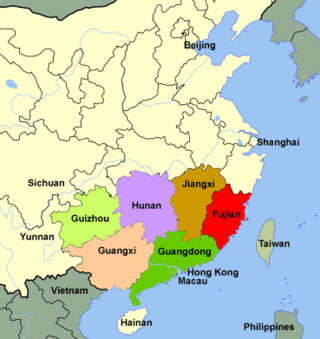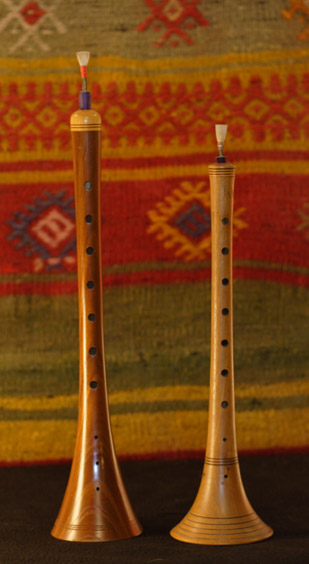The banjo is a stringed instrument with a thin membrane stretched over a frame or cavity to form a resonator. The membrane is typically circular, in modern forms usually made of plastic, originally of animal skin. Early forms of the instrument were fashioned by African Americans and had African antecedents. In the 19th century, interest in the instrument was spread across the United States and United Kingdom by traveling shows of the 19th century minstrel show fad, followed by mass-production and mail-order sales, including instruction method books. The inexpensive or home-made banjo remained part of rural folk culture, but 5-string and 4-string banjos also became popular for home parlor music entertainment, college music clubs, and early 20th century jazz bands. By the early 21st century, the banjo was most frequently associated with folk, bluegrass and country music, but was also used in some rock, pop and even hip-hop music. Among rock bands, the Eagles, Led Zeppelin, and the Grateful Dead have used the five-string banjo in some of their songs. Some famous pickers of the banjo are Ralph Stanley and Earl Scruggs.

Guangdong, formerly romanized as Canton or Kwangtung, is a coastal province located in South China, on the north shore of the South China Sea. The provincial capital is Guangzhou. With a population of 126.84 million across a total area of about 179,800 km2 (69,400 sq mi), Guangdong is the most populous province of China and the 15th-largest by area as well as the second-most populous country subdivision in the world.

Chaozhou, alternatively Chiuchow, Chaochow or Teochew, is a city in the eastern Guangdong province of China. It borders Shantou to the south, Jieyang to the southwest, Meizhou to the northwest, the province of Fujian to the east, and the South China Sea to the southeast. It is administered as a prefecture-level city with a jurisdiction area of 3,110 km2 (1,200 sq mi) and a total population of 2,568,387. Its built-up area encompassing most of Shantou and Jieyang cities was home to 12,543,024 inhabitants on 13 local administrative areas. Along with Shantou and Jieyang, Chaozhou is a cultural center of the Chaoshan region.

The music of China consists of many distinct traditions, often specifically originating with one of the country's various ethnic groups. It is produced within and without the country, involving either people of Chinese origin, the use of traditional Chinese instruments, Chinese music theory, or the languages of China. It includes traditional classical forms and indigenous folk music, as well as recorded popular music and forms inspired by Western culture.
Kyrgyz music is nomadic and rural, and is closely related to Turkmen and Kazakh folk forms. Kyrgyz folk music is characterized by the use of long, sustained pitches, with Russian elements also prominent.

The erhu is a Chinese two-stringed bowed musical instrument, more specifically a spike fiddle, which may also be called a Southern Fiddle, and is sometimes known in the Western world as the Chinese violin or a Chinese two-stringed fiddle.

The term Chinese orchestra is most commonly used to refer to the modern Chinese orchestra that is found in China and various overseas Chinese communities. This modern Chinese orchestra first developed out of Jiangnan sizhu ensemble in the 1920s into a form that is based on the structure and principles of a Western symphony orchestra but using Chinese instruments. The orchestra is divided into four sections – wind, plucked strings, bowed strings, and percussion, and usually performs modernized traditional music called guoyue. The orchestra may be referred to as Minzu Yuetuan or Minyuetuan in mainland China, Chung Ngok Tuen in Hong Kong, Huayuetuan in Southeast Asia, or Guoyuetuan in Taiwan.

Chaoshan or Teoswa is a cultural-linguistic region in the east of Guangdong, China. It is the origin of the Min Nan Chaoshan dialect (潮汕话). The region, also known as Chiushan in Cantonese, consists of the cities Chaozhou, Jieyang and Shantou. It differs linguistically from the rest of Guangdong province, which was historically dominated by Yue speakers, Hakka, and Leizhou Min speakers. However, Mandarin has recently become the dominant language in the region. It is historically important as the ancestral homeland of many citizens of other countries of Chinese descent, including Viets, Thais, Cambodians, Singaporeans, Malaysians, and Indonesians.

The music of the southern China has many features that are distinct from the rest of the country. For instance, many folk songs only use three notes. The region is home to significant populations of ethnic minorities, such as the Zhuang, Miao, She and Tai peoples.

The gaohu is a Chinese bowed string instrument developed from the erhu in the 1920s by the musician and composer Lü Wencheng (1898–1981) and used in Cantonese music and Cantonese opera. It belongs to the huqin family of instruments, together with the zhonghu, erhu, banhu, jinghu, and sihu; its name means "high-pitched huqin". It is the leading instrument of Cantonese music and opera ensembles. Well known pieces for the gaohu include Bu Bu Gao and Ping Hu Qiu Yue.
Cantonese culture, or Lingnan culture, refers to the regional Chinese culture of the region of Lingnan: twin provinces of Guangdong and Guangxi, the names of which mean "eastern expanse" and "western expanse", respectively.

Turkish folk music is the traditional music of Turkish people living in Turkey influenced by the cultures of Anatolia and former territories in Europe and Asia. Its unique structure includes regional differences under one umbrella. It includes popular music from the Ottoman Empire era. After the foundation of the Turkish Republic in 1923, Turkish President Mustafa Kemal Atatürk ordered a wide-scale classification and archiving of samples of Turkish folk music from around the country, which, from 1924 to 1953 collected more than 10,000 folk songs. Traditional folk music was combined with Western harmony and musical notation to create a more modern style of popular Turkish music.

The jinghu is a Chinese bowed string instrument in the huqin family, used primarily in Beijing opera. It is the smallest and highest pitched instrument in the huqin family. The jinghu has a tone similar to a violin but raspier.

The banhu is a Chinese traditional bowed string instrument in the huqin family of instruments. It is used primarily in northern China. Ban means a piece of wood and hu is short for huqin.
Guangdong music, also known as Cantonese music is a style of traditional Chinese instrumental music from Guangzhou and surrounding areas in Pearl River Delta of Guangdong Province on the southern coast of China. The name of the music is not an accurate description because Guangdong music is not the only music of the whole Guangdong area. Cantonese classical music especially were usually much livelier in pace and happier than those of other China provinces which is typical and the very essence of the Cantonese's character. In Guangdong, there are numerous traditional genres of music such as Teochew music and Hakka music. The name of the music originated in the 1920 and 1930s when the music was popular in Shanghai ballrooms in the form of "Spiritual Music". As the performers were almost entirely from Guangdong, Shanghai people generalized the form of music as Guangdong music. Musically, compositions are based on tunes derived from Cantonese opera, together with new compositions from the 1920s onwards. Some pieces have influences from jazz and Western music, using syncopation and triple time, and incorporating instruments such as the saxophone, violin, guitar, piano, drum set, or xylophone.

The erxian is a Chinese bowed string instrument in the huqin family of instruments. It has two strings and is used primarily in Cantonese music, most often in "hard string" chamber ensembles. In the 1920s, following the development of the gaohu, the erxian experienced a decline and since the late 20th century has been little used outside the tradition of Cantonese opera.
The yehu is a bowed string instrument in the huqin family of Chinese musical instruments. Ye means coconut and hu is short for huqin. It is used particularly in the southern coastal provinces of China and in Taiwan. The instrument's soundbox is made from a coconut shell, which is cut on the playing end and covered with a piece of coconut wood instead of the snakeskin commonly used on other huqin instruments such as the erhu or gaohu. As with most huqin the bow hair passes in between the two strings. Many players prefer to use silk strings rather than the more modern steel strings generally used for the erhu, giving the instrument a distinctly hollow, throaty timbre. The instrument comes in various sizes. In Chaozhou music it is a leading instrument, and is tuned quite high. In Cantonese music it can be quite large and is often tuned to a relatively low pitch, lower than the erhu. It is used as an accompaniment instrument in the local musics and operas of various areas, including Guangdong, Fujian, and Taiwan. It is an important instrument in the music of the Chaozhou and Hakka peoples. In Taiwan, a variety of yehu used in Taiwan opera is called kezaixian.

Teochew string music or Chaozhou xianshi is classed as a type of sizhu music although it typically uses stringed instruments only. It is found in northeastern Guangdong and parts of Fujian and also in regions with overseas Teochew populations, such as Malaysia, Singapore, Thailand, and the United States. The Chaoshan region of Guangdong, bordering on Fujian and comprising the cities of Chaozhou, Shantou and Jieyang, forms its own cultural sphere. Teahouses often accompany with Chaozhou music.

The tihu is a two-stringed bowed vertical fiddle in the huqin family, used in Chaozhou xianshi music of the Chaozhou people. It is an adaptation of the gaohu used in Cantonese music. It has a tubular hardwood body that is covered on the playing end with python skin. It is used in the Chaozhou people's original homeland of Chaozhou and Shantou, in eastern Guangdong, as well as in regions where Chaozhou people have immigrated, such as Thailand and Singapore.
Yue embroidery, or Guangdong embroidery, is a style of embroidery folk art of the Chaoshan and Pearl River Delta region. It encompasses Guangzhou embroidery (广绣) and Chaozhou embroidery (潮绣). It is one of the well-known "four great embroideries of China", the other three being Sichuan embroidery, Suzhou embroidery and Xiang embroidery.













